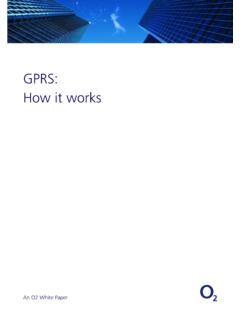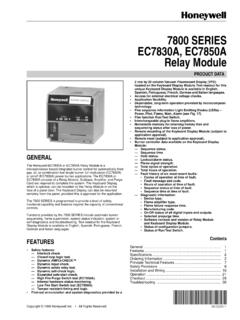Transcription of GPRS: How it works - O2
1 GPRS: how it works An O2 White Paper 1. Executive summary2. gprs network infrastructure3. gprs gprs PDP Context gprs Context Deactivation and What happens to an incoming voice call during a gprs data session?4. The importance of the access point name5. Connecting to the corporate LAN via Resilient O2 Mobile Web O2 Mobile Web VPN service6. How secure is gprs ?7. Throughput performance of the gprs Capabilities of the O2 gprs Multislot class of gprs gprs coding schemes8. Glossary of terms34-56-106789101112-1812141516181920 -2220212223 ContentsPage General Packet Radio Service ( gprs ) is anenhancement to the existing GSM network infrastructureand provides a connectionless packet data service. The same cellular base-stations that support voice callsare used to support gprs and as a consequence GPRScan be used wherever it is possible to make a voice roaming agreements exist with a large number ofcountries and this means users can use gprs deviceswhilst is based on internet Protocols (IP) and enablesusers to utilise a wide range of applications email and internet and/or intranet resources for instance.
2 With throughput rates of up to 40 Kbit/s, users have asimilar access speed to a dial-up modem, but with theconvenience of being able to connect from anywhere. gprs is classed as being a packet switched networkwhereby radio resources are used only when users are actually sending or receiving data. Rather thandedicating a radio channel to a mobile data user for afixed period of time, the available radio resource can beconcurrently shared between several users. This efficientuse of scarce radio resources means that large numbersof gprs users can potentially share the same bandwidthand be served from a single cell. The actual number ofusers supported depends on the applications being usedand how much data is being term always on always connected is often usedwhen people are describing gprs and means once usershave logged on they can remain connected to the datanetwork for the working day. It should be noted thatunlike GSM circuit switched data working, where thecost of the data call is related to the time spentconnected to the network, this is not an issue whenusing gprs as the cost of a gprs data session isdependant on the amount of data sent and received notthe time spent connected to the Executive summary42.
3 gprs network infrastructureGPRS introduces a number of new functional elementsthat support the end to end transport of IP based packetdata. gprs was developed by the GSM standards bodies,resulting in a system with defined functionality,interfaces and inter-network operation for roamingsupport. The gprs network architecture is shown inFigure major new core network elements are introduced:the Serving gprs Support Node (SGSN) and the GatewayGPRS Support node (GGSN). The SGSN monitors thestate of the mobile station and tracks its movementswithin a given geographical area. It is also responsible for establishing and managing the data connectionsbetween the mobile user and the destination GGSN provides the point of attachment between theGPRS domain and external data networks such as theinternet and Corporate Intranets. Each external networkis given a unique Access Point Name (APN) which is usedby the mobile user to establish the connection to therequired destination GSM Base Station Subsystem (BSS) is adapted tosupport the gprs connectionless packet mode ofoperation.
4 A new functional node called the PacketControl Unit (PCU) is introduced (as part of the BSC) to control and manage the allocation of gprs radioresources to mobile the context of this paper the term mobile station orMS refers to gprs devices could be handsets, PC datacards, handheld devices (such as O2 s XDA devices) or any other device that incorporates a gprs 1: gprs Network architecture diagram shown in Figure 1 shows anumber of standardised network interfaces: Gb frame relay connection between the SGSN andthe PCU within the BSS. This transports both userdata and signalling messages to/from the SGSN. Gn the gprs backbone network, implementedusing IP LAN/WAN technology. Used to providevirtual connections between the SGSN and GGSN. Gi the point of connection between gprs and theexternal networks, each referenced by the AccessPoint Name. This will normally be implementedusing IP WAN technology. Gr interface between the HLR and SGSN thatallows access to customer subscription information.
5 Gs optional interface that allows closer co-ordinationbetween the GSM and gprs networks. Gc optional interface that allows the GGSN accessto customer location number of other elements are also introduced (notshown on Figure 1): CG the Charging Gateway provides the means to collect and co-ordinate the billing informationproduced by the SGSN and GGSN before processingby the billing system. DNS the IP Domain Name Service is required to enable users to establish a data session with the destination network. It provides the mappingbetween APNs and GGSN IP gprs OperationThe HLR is the repository for all network relatedsubscription information. The functionality of the HLR hasbeen enhanced to include gprs details. Each user musthave at least one gprs subscription record containinginformation such as a list of networks (identified usingthe APN) to which access is allowed and the subscribedQuality of Service (QoS).
6 Further optional information maybe stored such as the users static IP user may have a subscription for both GSM andGPRS Subscription77 The MS must in the first instance, be known to thenetwork. This is achieved using the gprs attach attach procedure can be summarised as follows: The Mobile Station ( gprs device) first makes arequest for enough radio resources to enable thetransport of the Attach Request signalling assignment of the appropriate radiochannel,the Attach Request message is contains information about the user s identity, MScapabilities and current location. The SGSN constructs an Update Location messagethat is sent to the appropriate HLR. The HLR completes the location updating processand provides the user s gprs subscription record tothe SGSN. The SGSN signals to the MS that the procedure completion of the Attach procedure, the networkis capable of tracking the MS (via subsequent locationupdates) and is aware of the services and networks thatthe user may have access to.
7 At this point the user is notable to send or receive gprs Attach8In order to enable user data transfer, a Packet Data Protocol(PDP) Context must be activated in the MS, SGSN andGGSN. This procedure is initiated by the user and isanalogous to logging on to the required destinationnetwork. The process is illustrated in Figure The user will initiate the logging on process using anapplication on the PC or MS. This signalling message includes key informationsuch as the APN of the external network to whichconnectivity is requested, the user s identity andany necessary IP configuration parameters ( for security purposes). The SGSN receives the Activate PDP context messageand check the user s subscription record todetermine if the request is If the request is valid, the SGSN sends a querycontaining the requested APN to the DNS The DNS server uses the APN information todetermine the IP address of a GGSN that will providethe required connectivity to the external GGSN IP address is returned to the The SGSN uses the GGSN IP address to request aconnection (tunnel) to the The GGSN upon receipt of this request completes theestablishment of the tunnel and returns an IP addressto be conveyed to the MS.
8 The GGSN associates thetunnel with the required external network The SGSN sends an Activate PDP context responsemessage to the MS (including IP address) packetexchange can now completion of this procedure, a virtual connection isestablished between the MS and the GGSN. The GGSN alsohas an association between the tunnel and the physicalinterface to the external network. Data transfer may nowtake place between the MS and the external PDP Context ActivationFigure 2: PDP Context Activation provides two additional, independent, proceduresthat enable a PDP context to be deactivated and the MS to disassociate itself from the network ( detach).An implicit context deactivation takes place if the MSinvokes the detach procedure. gprs detach may beperformed when: The MS is powered off. The MS is detached from the network if it stays outof coverage for a period that exceeds the mobilereachable timer ( 3 hours in O2 s network).
9 User wishes to detach from the gprs network, butwants to remain attached to the GSM network forcircuit switched gprs Context Deactivation and What happens to an incoming voice call during a gprs data session?10 The vast majority of gprs devices ( mobile handset,laptop datacard, O2 XDAII etc.) are categorised as beingClass B mobile devices. Class B devices can be attachedto both the gprs and GSM networks, but they cannottransmit or receive on both simultaneously. If a mobile is in an active gprs data session when anincoming voice call is detected, the user will normally benotified by an on-screen message, and will then have theoption to suspend the data session and accept the call,or continue with the data session and reject the diagram shown in Figure 3 illustrates the process. Inthis example the Call Line Identity (CLI) of the caller hasbeen recognised by the handset of the gprs user, andtherefore the caller s name appears in the display.
10 If theuser accepts the call the gprs data session is suspendeduntil the user ends the the detach procedure is invoked, any active contextwill be automatically 3: Voice Call is Received whilst a gprs Data Call is in CCoonntteexxtt AAccttiivveeGGPPRRSSSS eessssiioonnPPeetteerrAAnnsswweerrPPeett eerrEEnndd001122::4422 GGPPRRSSPP aauusseeRReessuummeeGGPPRRSSSS eessssiioonnGGPPRRSSSS eessssiioonnIInnccoommiinngg CCaallllCCaallll RReejjeecctteeddUUsseerr eennddss ccaallllIIddllee DDiissppllaayyGGPPRRSS ddaattaa sseessssiioonnPPllaacceedd oonn hhoollddUUsseerr CChhoooosseess ttoo eennddGGPPRRSS ddaattaa sseessssiioonnGGPPRRSS DDaattaa SSeessssiioonnrreessuummeess wwhheerree iitt lleefftt ooffffCOKOKOKC11 Each data network connected to O2 s gprs network isan access point , identified by a unique Access PointName (APN). The access point may be classed as eitherprivate or public. This determines whether O2 carries outa preliminary validation of the gprs user s subscriptionrecord before forwarding their access request to thatdata network.






